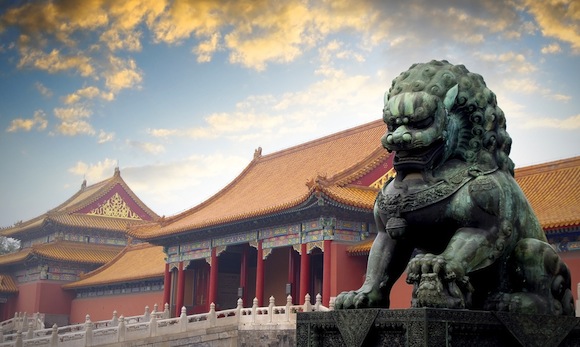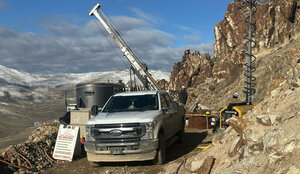The Mining Report: In early January on your Technology Metals Research blog you wrote, "China is still as much in charge of its rare earth elements (REE) supply as it ever was," after China abolished export quotas in favor of an export licensing system. What is the Chinese government's goal here?
Gareth Hatch: It's twofold. One is to get control of its entire REE supply chain, but it's also about generating more revenue. China is going to abolish REE export tariffs, which is a requirement of the recent World Trade Organization (WTO) ruling, and that will happen in May. By doing so, China is saying, "We'll sort of play by the WTO rules." But Chinese officials are now talking about replacing tariffs with a value-added resource tax.
"Alkane Resources Ltd. is funding the Dubbo Zirconia project with nearby gold production."
Another noteworthy aspect of these measures is that a considerable percentage of REE exports from China are smuggled out of the country and that means lost tax revenues. China is trying to address those leaks. The new system requires that a license be issued on a shipment-by-shipment basis, but it's not quite clear yet what set of rules and regulations are applied internally or what paperwork is required. That was likely reflected in the lower-than-expected REE export numbers in January.
TMR: There's also some government-mandated consolidation happening in China's REE space. What is happening and why are those changes important?
GH: This has been going on for well over a year. Chinese authorities are consolidating the industry into six conglomerates, referred to as the "five plus one." The one is the large entity in northern China that used to be Baosteel, now called China Northern Rare Earth Group, which controls most of the country's light rare earth production. There are five other entities into which companies are tucked or subsumed. Basically, it's to gain further control of the industry by making the managers of the largest companies responsible for the activities of the companies further down the supply chain.
"Commerce Resources Corp. has developed a process to produce concentrate with a relatively high concentration of REEs."
In the last year China has closed many obsolete facilities in an effort to modernize and improve efficiency, as well as reduce illegal mining and smuggling. China is putting the groundwork in place to produce these materials, critical materials, in a way that prepares for higher prices. I would argue it's laid the groundwork for the long-term survival and prosperity of the Chinese rare earth industry in an era when pollution and environmental issues are growing more significant there.
TMR: What's next?
GH: The biggest question is: What happens as we transition away from a tariff, which until May could be anything from 15% to 25% on top of normal Chinese prices, to a value-added resource tax? All things being equal, prices of REE exports should stay about the same—it's the internal price that will go up because those end-users weren't used to paying that tax. And what will the impact of that be?
Once that's smoothed out, all signs are that prices will start to increase somewhat, but REE prices should in theory be the same whether you're using them in China or you're using them outside, with perhaps one or two exceptions like dysprosium and terbium. The rare earth industry in China is rapidly turning into supply chains that produce at a much higher standard for pollution and environmental control, and that means that there's also a potentially level playing field.
TMR: What's the likely impact on rare earth equities of these measures committed to by the Chinese government?
GH: There are two potential impacts, both of which, for companies trying to develop capacity outside of China, work in their favor. One, any time prices are likely to increase there are two potential reactions. If the prices go crazy—and we witnessed that in 2010–2011—demand goes down. But if prices go to a level just above the cost of production where there's a floor on the price that takes into account environmentally sound processing, then it becomes easier in theory to compete if you're going to produce REE in an environmentally sustainable manner. This should benefit the two projects that are up and running outside of China and the others that investors are most interested in.
"Focus Graphite Inc. has one of the most advanced graphite projects in North America."
Then there is the issue of internal Chinese demand. Are the Chinese GDP growth numbers real? Even the most conservative predictions suggest that there will continue to be increased demand for the high-tech consumer goods that require REEs. The theory is that demand for high-tech goods will increase REE demand inside of China, which may affect the ability to source REEs outside of China. For the first time in a couple of years, the picture looks more rosy if you're in the rare earth sector outside of China.
TMR: Do you see a day when China will be a net importer of rare earths?
GH: It's possible for certain rare earths. And there is a possibility that companies outside of China could produce REEs at prices that compete with the Chinese. One sign of that shift happened when Tantalus Rare Earths AG (TEATF:OTC; TAEN:GR) announced a joint venture with Shenghe Resources Holding Co. Ltd., a Chinese rare earth company with the third largest mine in China. Tantalus has a REE project in Madagascar and Shenghe basically plans to buy concentrate from that future mine to produce oxides in China because that could be more strategically advantageous than continuing to mine REE deposits in China.
TMR: China is obviously the biggest ongoing narrative in the REE space, but another key issue is processing and processing costs. Are there two or three promising processing technologies that you can tell us about?
GH: There have certainly been announcements in the last several months relating to new processes that are being evaluated to separate rare earths. Ucore Rare Metals Inc. (UCU:TSX.V; UURAF:OTCQX) is working with a company in the U.S. on something called Molecular Recognition Technology (MRT), which purports to selectively home in on rare earths in solution and get them out without solvent extraction. I'm not a fan of 'science via press release.' It remains to be seen how it all works.
"One name that I keep track of is Mason Graphite Inc."
Another one is Texas Rare Earth Resources Corp. (TRER:OTCQX), which is trying to use something called continuous ion exchange. That is a combination of the well-established ion exchange columns on a continuous processing basis—with the goal of not having to do laborious solvent extraction. And Rare Element Resources Ltd. (RES:TSX; REE:NYSE.MKT) appears to have developed a process that produces high-purity rare earth concentrates with no thorium or other deleterious elements. The purity is as high as four or five nines (99.99-99.999%), which is really quite remarkable.
TMR: Your company, Technology Metals Research, is working with the U.S. Department of Defense (DOD) on processing technologies. Please tell us about that.
GH: Technology Metals Research is overseeing a project that's being funded by the Army Research Laboratory, which is part of the DOD. My other company, Innovation Metals, is a project participant and has a lab-scale solvent-extraction pilot plant in operation in the outskirts of Toronto, Canada, using proven technology and process-flow diagrams to optimize processes for the separation of heavy rare earth concentrates. The project is also looking at three new processes, two of which are based on the same chemistry as solvent extraction but with reaction rates that are orders of magnitude greater than existing methods.
"Namibia Rare Earths Inc.'s Lofdal has great rare earth distribution and simple mineralogy."
The initial results are promising; these processes could considerably speed up processing, which would ultimately reduce the hardware footprint and capital costs for a commercial facility. The third process uses biology as a means of producing rare earths. The idea is to use biological entities to precipitate pure metals and oxides.
TMR: Are there plans to commercialize this technology?
GH: Yes, commercialization is the goal. The first round of funding is to verify the proof of concepts and compare them to the solvent extraction that Innovation Metals Corp. is doing. The funding from the Army Research Lab is part of an overall initiative to help develop a domestic supply chain for critical rare earths. It's no good having mines in the U.S. or Canada producing rare earths if you can't turn them into useful products here.
TMR: Technology Metals Research maintains the Advanced Rare Earth Projects Index. What are some companies on that index with news worth sharing?
GH: Tasman Metals Ltd.'s (TSM:TSX.V; TAS:NYSE.MKT; TASXF:OTCPK; T61:FSE) Norra Kärr deposit in Sweden recently completed a prefeasibility study. It's a nice deposit with a great strategic location—it's clearly the best REE deposit in Europe. At the end of the day you need cold hard cash to advance projects. Europe will show its interest by investing in the project.
A chart of Value Metrics for Advance Rare Earth Projects is available here.
TMR: What are some other companies with news?
GH: Northern Minerals Ltd. (NTU:ASX) recently received its environmental permits for the Browns Range deposit in Australia and has started a bankable feasibility study there; it just announced a nearly $50M financing deal to make that happen.
Namibia Rare Earths Inc. (NRE:TSX; NMREF:OTCQX) recently published its first preliminary economic assessment (PEA) for the Lofdal REE project in Namibia. I helped put together the market study for that report. Northern Minerals and Namibia Rare Earths have two projects with some of the highest percentages of HREEs. Both projects are hosted in xenotime mineralization, which has relatively straightforward metallurgy.
TMR: Does the relatively high distribution of HREEs in those respective deposits make it easier for those companies to raise money for development?
GH: It makes it easier to get their feet in the door, but the overall grade is important. If there is a lot of dysprosium and terbium in a xenotime deposit, that is very attractive but you can't just focus on that. Xenotime, eudialyte or other minerals that contain heavy rare earths tend to be low-grade deposits. That then becomes an issue of mining and production, and the cost and challenges associated with that. You have to look at factors like overall grade, recovery rates and costs of infrastructure.
TMR: You helped complete the market study for the Lofdal PEA. What are your thoughts on that project?
GH: Lofdal has great rare earth distribution and simple mineralogy. It still needs some infrastructure but it has great potential. One thing I would look for Namibia Rare Earths to do is to eventually expand the size of the mineral resource.
TMR: Any others?
GH: Another company on the index is Commerce Resources Corp. (CCE:TSX.V; D7H:FSE; CMRZF:OTCQX), which is operating a mini pilot plant to process a bulk sample from the Ashram REE deposit in Quebec. Commerce has basically developed a process to produce concentrate with a relatively high concentration of REEs. Ideally, the company would need to scale up and show that it can do it on at least a semi-continuous basis with a much larger sample, which means being exposed to more variability. The company is trying to confirm that it has a process that works to produce a viable mineral concentrate. It's an important part of any project in order to move it forward.
TMR: You mentioned Ucore earlier. It has a PEA on the Bokan Mountain project in Alaska. What's the next step?
GH: Its PEA is way out of date on pricing and it's due for an update. Ucore has started on a feasibility study and it appears that the company will have financial support from the Alaskan government for at least part of the costs. But any decision on financing will rely on a comprehensive feasibility study report. Ucore is hoping to get that feasibility study done this year.
TMR: Does it have a leg up on other REE developers given the support from the Alaskan government?
GH: There are significant benefits but we have to be clear as to what that support is. The Alaskan government's commitment of $145 million hinges on the outcome of the feasibility study. Although the potential funding is conditional, it's a significant plus for the project and other investors will see that as a positive. Of course, Ucore has excellent support from Senator Lisa Murkowski, who is now chair of the U.S. Senate Committee on Energy & Natural Resources.
TMR: What about other projects in Australia?
GH: Alkane Resources Ltd. (ALK:ASX; ANLKY:OTCQX;), which is also in the index, is funding the Dubbo Zirconia project with nearby gold production. It's a great idea. I had the chance to visit the deposit and demo plant in Australia a few years ago. I've always liked that project from a technical point of view. Alkane has the process locked in and it knows exactly what it needs to do. If you have another project that can generate cash flow that's a great thing, and Alkane's Tomingley gold project has been operating very well, but the Dubbo project still needs more money than what Tomingley alone can generate. Ultimately there are very few junior mining companies in the REE sector that are generating revenues. I think that's a plus. It's ready to go once Alkane has the financing.
TMR: What's the timeline for getting Dubbo permitted?
GH: Alkane was recently informed by the local plan assessment commission that the environmental permits have been approved, subject to the usual conditions. I am not aware of any major issues. Dubbo will produce not just rare earths, but zirconium and niobium, so there's a medley of metals. Alkane will not only rely on REEs to generate revenue.
TMR: Let's switch gears to graphite, and graphene in particular, which is getting attention in the mainstream media. What is real and what is hype?
GH: I'm a material scientist by training. I've been aware of graphene since it was first produced at the University of Manchester in the U.K., close to where I grew up. Graphene definitely holds a lot of promise. Some of the hype is justified in light of the things that you can do with this stuff, but it boils down to how do you produce this material at a reasonable cost.
Second, we have to remember that it doesn't take a lot of graphite to make graphene into the light-technology items people are talking about. A little graphene goes a long way. This isn't a story of tens or hundreds of thousands of tons of graphite being turned into graphene so much as it is what is the technology sector willing to do with it at various price points. As you lower the cost of producing it in bulk, what windows will open? It is sometimes hard to evaluate exactly what progress the folks working on the production side are making. I take the news reports with a pinch of salt, but the promise is definitely there if we can make it at a reasonable price.
TMR: What are some companies with what you would consider the most advanced graphite projects?
GH: There's a handful that I follow on our Advanced Graphite Projects Index. Names that come to mind include Northern Graphite Corporation (NGC:TSX.V; NGPHF:OTCQX) in Canada with the Bissett Creek deposit and Focus Graphite Inc. (FMS:TSX.V; FCSMF:OTCQX; FKC:FSE) with the Lac Knife deposit In Quebec. These companies are at the feasibility study level. They're working to determine if it is possible to turn the material from their respective projects into battery-grade graphite.
Other names that I keep track of are Mason Graphite Inc. (LLG:TSX.V; MGPHF:OTCQX) with the Lac Guéret graphite project in Quebec. I recently visited Canada Carbon Inc.'s (CCB:TSX.V) Miller vein graphite project in Québec but it's not on our index because it does not have an NI 43-101-guided mineral resource estimate yet.
We probably have to keep an eye on what Zenyatta Ventures Ltd. (ZEN:TSX.V) is doing with its Albany deposit in Ontario. And the last one I'll mention is Graphite One Resources Inc. (GPH:TSX.V), which has the Graphite Creek deposit in Alaska. It's a large deposit and if it can develop a good quality project in Alaska, it could open the door for the state government and others to help develop it.
TMR: Focus Graphite bills itself as the most advanced battery-grade graphite project in North America. Are lithium-ion batteries and other power cells driving investment in this space?
GH: Yes, the driver here is energy storage. There's been a lot of buzz since Tesla Motors Inc. (TSLA:NASDAQ) announced its plan to build a "Gigafactory" for the production of a variety of parts and components including the lithium-ion batteries required to power its vehicles and others. Tesla's stated goal is to source all of its materials from North America. The production of hundreds of thousands of vehicles per year means that we are going to build batteries using anodes that contain graphite.
The questions is: Will it be natural graphite or synthetic? If companies can demonstrate that they can consistently deliver a product that meets Tesla's needs at a cost that is competitive to synthetic graphite, they may have a winning graphite project. That immediately puts the focus on the most advanced projects in North America. Focus Graphite is one of those companies. If it can scale up and do what it says it can do, it could certainly be a contender.
TMR: 2015 will be remembered as the year of what in the REE space?
GH: This may be the year of innovative processes. I think we'll really start to see what's real and what isn't this year in REE processing. Perhaps a technology will be established as a game-changer.
The other thing would be the reemergence of a stronger, leaner Chinese REE sector. The REE industry in China for the last two or three years has been all about export quotas and tariffs. But this unprecedented consolidation and coordination is something to keep an eye on because it will affect potential supply in ways that are positive for folks with an interest in rare earth projects outside of China.
TMR: Thank you for your insights, Gareth.
 Gareth Hatch is a founding principal of Technology Metals Research LLC, providing market intelligence and analysis on the supply chain for rare earths and other critical materials. He is also president of Innovation Metals Corp., a private Canadian company focused on the creation of centralized rare-earth separation facilities in North America.
Gareth Hatch is a founding principal of Technology Metals Research LLC, providing market intelligence and analysis on the supply chain for rare earths and other critical materials. He is also president of Innovation Metals Corp., a private Canadian company focused on the creation of centralized rare-earth separation facilities in North America.
For several years, Hatch was director of technology at Dexter Magnetic Technologies. He holds five U.S. patents on a variety of magnetic devices. A two-time graduate of the University of Birmingham in the U.K., Hatch has a Bachelor of Engineering with Honours in materials science and technology and a Ph.D. in metallurgy and materials, focused on rare earth permanent-magnet alloys. He is a Fellow of the Institute of Materials, Minerals & Mining, a Fellow of the Institution of Engineering & Technology, a Chartered Engineer and a senior member of the IEEE. Hatch is also a member of the Strategic Materials Advisory Council.
Read what other experts are saying about:
Want to read more Mining Report articles like this? Sign up for our free e-newsletter, and you'll learn when new articles have been published. To see recent interviews with industry analysts and commentators, visit our Mining Report home page.
DISCLOSURE:
1) Brian Sylvester conducted this interview for Streetwise Reports LLC, publisher of The Gold Report, The Energy Report, The Life Sciences Report and The Mining Report, and provides services to Streetwise Reports as an independent contractor. He owns, or his family owns, shares of the following companies mentioned in this interview: None.
2) The following companies mentioned in the interview are sponsors of Streetwise Reports: Alkane Resources Ltd., Commerce Resources Corp., Focus Graphite Inc., Mason Graphite Inc. and Namibia Rare Earths Inc. The companies mentioned in this interview were not involved in any aspect of the interview preparation or post-interview editing so the expert could speak independently about the sector. Streetwise Reports does not accept stock in exchange for its services.
3) Gareth Hatch: I own, or my family owns, shares of the following companies mentioned in this interview: Technology Metals Research and Innovation Metals Corp. I personally am, or my family is, paid by the following companies mentioned in this interview: Technology Metals Research and Innovation Metals Corp. My company has a financial relationship with the following companies mentioned in this interview: None. I was not paid by Streetwise Reports for participating in this interview. Comments and opinions expressed are my own comments and opinions. I determined and had final say over which companies would be included in the interview based on my research, understanding of the sector and interview theme. I had the opportunity to review the interview for accuracy as of the date of the interview and am responsible for the content of the interview.
4) Interviews are edited for clarity. Streetwise Reports does not make editorial comments or change experts' statements without their consent.
5) The interview does not constitute investment advice. Each reader is encouraged to consult with his or her individual financial professional and any action a reader takes as a result of information presented here is his or her own responsibility. By opening this page, each reader accepts and agrees to Streetwise Reports' terms of use and full legal disclaimer.
6) From time to time, Streetwise Reports LLC and its directors, officers, employees or members of their families, as well as persons interviewed for articles and interviews on the site, may have a long or short position in securities mentioned. Directors, officers, employees or members of their families are prohibited from making purchases and/or sales of those securities in the open market or otherwise during the up-to-four-week interval from the time of the interview until after it publishes.









































